The Women Personal Massager Market is estimated to be valued at USD 3.4 billion in 2025 and is projected to reach USD 7.4 billion by 2035, registering a compound annual growth rate (CAGR) of 8.2% over the forecast period. A saturation point analysis reveals an initial phase of strong growth, followed by signs of market stabilization as the product becomes more widely adopted. Between 2025 and 2030, the market grows from USD 3.4 billion to USD 5.0 billion, contributing USD 1.6 billion in growth, with a CAGR of 9.0%.
This early-stage growth is driven by increasing consumer awareness of the benefits of personal well-being and wellness, particularly in emerging markets. As more women discover the benefits of personal massagers, particularly in terms of stress relief and enhanced physical comfort, the market experiences significant growth. The first peak occurs at USD 5.0 billion in 2030, followed by a deceleration between 2030 and 2032, where the market grows from USD 5.0 billion to USD 5.4 billion, adding USD 0.4 billion in growth, with a slower CAGR of 3.9%.
This slowdown signals the market nearing its saturation point as a large portion of the target demographic has already adopted these products. From 2032 to 2035, the market continues to grow from USD 5.4 billion to USD 7.4 billion, contributing USD 2 billion in growth, with a stronger CAGR of 10.5%. This acceleration is driven by innovations in product design and marketing, as well as increasing acceptance of these devices as part of mainstream wellness and self-care routines.
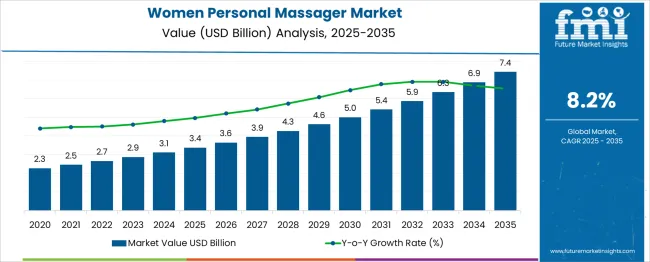
| Metric | Value |
|---|---|
| Women Personal Massager Market Estimated Value in (2025E) | USD 3.4 billion |
| Women Personal Massager Market Forecast Value in (2035F) | USD 7.4 billion |
| Forecast CAGR (2025 to 2035) | 8.2% |
The women personal massager market is witnessing significant growth as changing lifestyles, rising health awareness, and increasing acceptance of personal wellness products converge to create sustained demand. The market has been influenced by heightened focus on self-care routines and the growing normalization of intimate wellness solutions among women.
Product innovation aimed at improving comfort, usability, and discretion has enhanced appeal across different demographics. The market outlook remains positive as manufacturers continue to invest in ergonomic designs, silent motor technologies, and premium materials that align with evolving consumer preferences.
Furthermore, growing penetration of e-commerce channels and enhanced privacy measures in distribution are expected to expand the market’s reach. The combination of wellness-centric marketing strategies, broader societal acceptance, and technological advancements is paving the way for continued adoption and deeper market penetration.
The women's personal massager market is segmented by product type, power source, purpose, consumer group, application, distribution channel, and geographic regions. By product type, the women's personal massager market is divided into Handheld massagers, Shiatsu massagers, Percussion massagers, and Others (wand massagers, portable massagers). In terms of power source, the women's personal massager market is classified into battery-powered and corded electric. Based on purpose, the women's personal massager market is segmented into Pain relief, Menstrual relief, Muscle therapy, Myofascial release, Skincare, Stress relief, and tissue therapy.
By consumer group, the women's personal massager market is segmented into Athletes and fitness enthusiasts, Office workers, and anti-aging medical use. By application, the women's personal massager market is segmented into Neck and shoulder massagers, back massagers, Foot massagers, Hand massagers, Head massagers, and Others (eye massage massager, thigh massager, ankle massager, leg massager). By distribution channel, the women personal massager market is segmented into Online and Offline. Regionally, the women personal massager industry is classified into North America, Latin America, Western Europe, Eastern Europe, Balkan & Baltic Countries, Russia & Belarus, Central Asia, East Asia, South Asia & Pacific, and the Middle East & Africa.
When segmented by product type, handheld massagers are projected to account for 42.3% of the total market revenue in 2025, positioning this segment as the leader. This leadership has been reinforced by the versatility and ease of use that handheld designs offer, allowing for targeted relief of specific body areas with user-controlled pressure and movement.
The compact and portable nature of these products has enabled their widespread adoption, particularly among consumers seeking convenience and discretion. Advances in ergonomic designs and customizable speed and vibration settings have further increased appeal among diverse age groups.
The ability to combine affordability with enhanced functionality has solidified the handheld massager segment’s dominance, meeting the growing demand for self-administered wellness solutions that integrate seamlessly into daily routines.
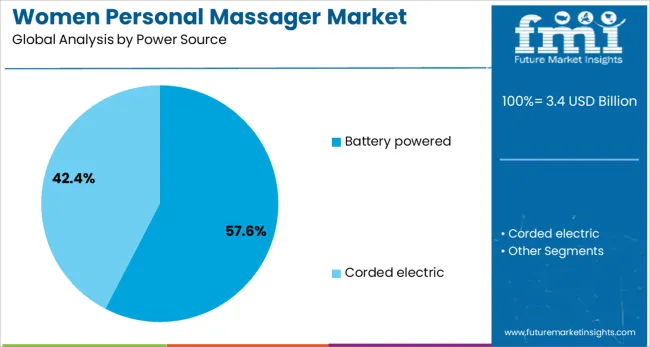
Segmenting the market by power source shows that battery powered devices are expected to hold 57.6% of the total revenue in 2025, making it the leading segment. This dominance has been driven by the portability and convenience that battery powered massagers provide, enabling users to operate the device without dependence on fixed power outlets.
Improvements in battery life and charging efficiency have increased usability and reduced maintenance concerns, which has strengthened consumer confidence in this segment. The compact design made possible by battery integration has also supported discreet use and easy storage, appealing to users prioritizing privacy and mobility.
Additionally, advancements in rechargeable technologies have enhanced sustainability and cost effectiveness over time, reinforcing the preference for battery powered solutions in the personal wellness category.
When analyzed by purpose, pain relief is forecast to contribute 29.4% of the total market revenue in 2025, establishing itself as the leading segment. This position has been supported by rising awareness of non-pharmaceutical pain management methods and increasing incidence of muscular discomfort due to sedentary lifestyles and stress.
The demand for safe, accessible, and immediate relief solutions has driven adoption of massagers specifically designed for alleviating localized pain. Manufacturers have responded by developing products with targeted vibration patterns and intensity controls tailored for pain relief applications.
The shift toward holistic wellness practices and avoidance of prolonged medication use has further reinforced the appeal of this segment. Its prominence reflects the growing consumer inclination toward therapeutic, non-invasive solutions that integrate seamlessly with self-care routines while addressing common discomfort effectively.
The women's personal massager market is experiencing growth due to increased awareness of self-care and wellness. As women seek ways to relax, relieve stress, and improve overall health, personal massagers are becoming essential tools in their daily routines. Technological advancements, such as app-controlled devices and improved battery life, are enhancing the functionality of these products. The growing focus on sexual wellness and personal well-being is further supporting the market. Despite challenges related to stigma and market saturation, the demand for innovative, user-friendly, and discreet massagers continues to rise.
The rising demand for wellness and self-care products is a key factor driving the growth of the women’s personal massager market. As modern women juggle busy schedules, they seek effective ways to relieve stress, improve circulation, and promote relaxation. Personal massagers provide a convenient and efficient solution, helping users unwind after long days. With an increasing focus on mental and physical well-being, more women are incorporating self-care routines into their lifestyles, leading to higher demand for products that support relaxation and wellness. As awareness of self-care's importance continues to grow, personal massagers are becoming essential tools for improving quality of life, health, and emotional well-being, especially among individuals seeking affordable, at-home wellness solutions.
A major challenge in the women's personal massager market is overcoming the stigma attached to these products. While acceptance is growing, cultural and societal barriers still exist, especially in regions where there are conservative views regarding sexual wellness. This stigma can limit the adoption of personal massagers among certain demographic groups. The market is becoming saturated with a wide range of similar products, which creates significant competition. Manufacturers must differentiate their offerings through unique features, high-quality materials, and targeted marketing. As many products in this category serve similar purposes, it can be difficult for brands to stand out and meet the diverse preferences of consumers.
The women personal massager market offers significant growth opportunities driven by technological innovations and growing consumer awareness of wellness. As technological advancements enhance product features, modern massagers now offer app-controlled functionality, customizable vibration settings, and extended battery life, making them more appealing to tech-savvy consumers. The increasing focus on sexual wellness and self-care is creating further opportunities, as more women embrace these products as essential tools for enhancing their health and well-being. As people become more open to the idea of self-pleasure and wellness products, the market continues to expand. Companies can take advantage of the growing demand for discreet, easy-to-use devices by creating high-quality, versatile massagers.
A significant trend in the women personal massager market is the integration of smart technology, which enhances user experience by offering features like app connectivity, remote control, and real-time performance monitoring. These advancements provide users with the ability to customize settings such as vibration intensity, patterns, and duration. As consumers increasingly demand personalization, products that cater to individual preferences are gaining popularity. The demand for compact, discreet, and portable designs that can be easily stored is also on the rise, particularly among busy women looking for convenience. The trend of integrating wellness benefits with pleasure features is shaping product development. Massagers that not only provide relaxation but also offer health benefits, such as stress reduction and improved blood circulation, are gaining traction.
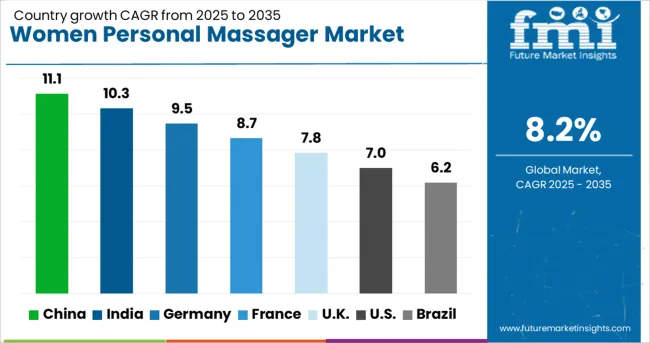
| Country | CAGR |
|---|---|
| China | 11.1% |
| India | 10.3% |
| Germany | 9.5% |
| France | 8.7% |
| UK | 7.8% |
| USA | 7.0% |
| Brazil | 6.2% |
The women personal massager market is expanding globally at a CAGR of 8.2% from 2025 to 2035. China leads the market with a growth rate of 11.1%, followed by India at 10.3%. Germany is experiencing a growth rate of 9.5%, while the UK. and USA show growth rates of 7.8% and 7.0%, respectively. The increasing demand for personal care products and the growing awareness about health and wellness are key drivers of the market. The rise of e-commerce, along with changing social attitudes toward self-care and intimacy, is further fueling demand for women personal massagers. Consumer preferences for privacy, convenience, and personalized wellness experiences are contributing to the market’s growth across different regions. The analysis includes over 40+ countries, with the leading markets detailed below.
The women personal massager market in China is growing at a CAGR of 11.1% through 2035. The growing awareness of personal wellness and self-care, particularly among urban consumers, is a primary factor contributing to this growth. The increasing disposable income, coupled with rising interest in sexual health and wellness products, is driving the demand for personal massagers in China. The growing focus on health, along with the influence of social media and e-commerce platforms, has made personal care products more accessible. As more women embrace self-care rituals, the market for women’s personal massagers is gaining significant traction in both metropolitan and smaller cities.
The women personal massager market in India is expected to grow at a CAGR of 10.3% from 2025 to 2035. The rising awareness of health, wellness, and self-care among women in India is driving this market’s expansion. As disposable income increases and consumer preferences shift towards self-care products, the demand for personal massagers is growing rapidly. India’s young and tech-savvy population is increasingly purchasing wellness products through online platforms, further fueling the growth of the market. The influence of wellness and beauty influencers, alongside growing acceptance of personal care products, is expected to drive continued market expansion in the coming years.
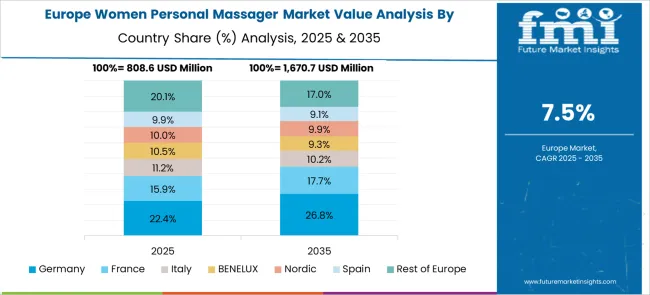
The women personal massager market in Germany is expanding at a CAGR of 9.5% through 2035. The increasing awareness about personal wellness and sexual health, combined with a growing trend towards self-care products, is fueling the demand for women’s massagers in the country. Germany’s well-established wellness industry, coupled with a strong focus on body care and hygiene, is contributing to the market’s growth. The rising popularity of wellness tourism and spa treatments also supports demand for massagers. A strong e-commerce presence is making these products more accessible to consumers, further enhancing market growth.
The UK women personal massager market is expected to grow at a CAGR of 7.8% through 2035. The increasing interest in self-care and personal wellness, along with rising disposable income, is driving demand for these products. In addition, the UK market is seeing a shift in consumer attitudes towards sexual wellness products, leading to more openness about their use. The growing focus on mental and physical well-being, coupled with advancements in product design and technology, further supports market growth. The widespread availability of personal massagers through both online and offline channels is further fueling the market’s expansion in the UK.
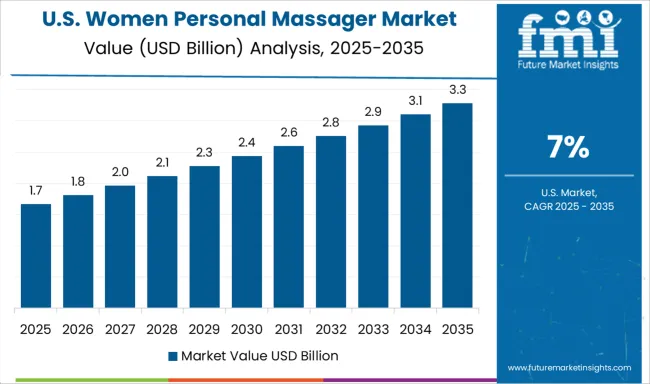
The USA women personal massager market is projected to grow at a CAGR of 7.0% from 2025 to 2035. The growing focus on personal wellness, mental health, and relaxation is propelling demand for women’s personal massagers. Increasing acceptance of sexual health products, along with the rise in consumer awareness about their benefits, is contributing to the market's growth. The USA market is benefiting from the increasing use of e-commerce platforms and the influence of beauty and wellness influencers. As wellness products become more mainstream and available, the demand for personal massagers continues to grow across various demographic groups.
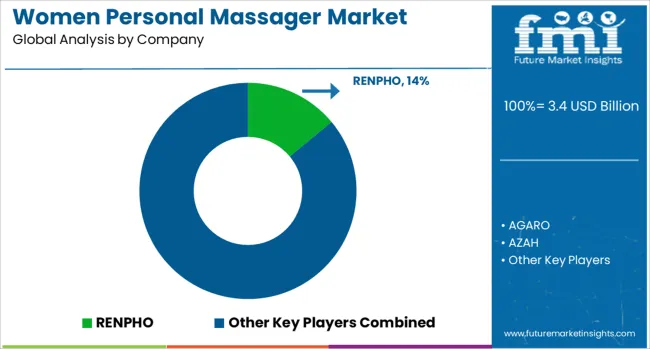
The women personal massager market is driven by companies specializing in wellness and relaxation products designed to improve comfort, relieve muscle tension, and support overall well-being. RENPHO is a market leader, offering a wide range of high-quality, user-friendly personal massagers that emphasize ease of use and affordability, catering to the growing demand for at-home wellness solutions. AGARO focuses on providing innovative and reliable massagers that target stress relief, muscle relaxation, and general wellness, with an emphasis on both performance and affordability.
AZAH specializes in premium women’s personal massagers, providing products that offer therapeutic benefits and sleek, modern designs for optimal comfort. Brookstone is well-known for offering advanced, high-performance personal massagers, combining cutting-edge technology with luxury designs. Dealsure focuses on providing affordable, efficient, and compact massagers, ensuring an entry point for budget-conscious consumers. Dr Physio and HealthSense offer a variety of personal massagers, with both brands focusing on providing products designed for both relaxation and pain relief, targeting a wide demographic of women seeking at-home wellness solutions.
HoMedics is recognized for its extensive line of personal massagers, integrating advanced features and ergonomic designs for ease of use. JSB Wellness, Lifelong, and Naipo provide cost-effective massaging products with a focus on comfort, relaxation, and usability, ensuring their products are accessible to a broad consumer base. PureWave by PADO offers high-tech, multi-functional massagers with powerful performance aimed at rejuvenating and soothing women’s muscles.
RoboTouch and TOUCHBeauty provide personal massagers with advanced technology features, ensuring comfort and effective stress relief. Zyllion is another key player, known for producing affordable yet effective personal massagers aimed at relieving muscle tension and promoting relaxation. Competitive differentiation in this market is driven by factors such as design, portability, price, performance, and additional features such as adjustable intensity levels and vibration modes. Barriers to entry include the need for high-quality materials, effective marketing strategies, and the ability to meet growing demand for wellness products. Strategic priorities include offering multi-functional devices, expanding product offerings, and integrating innovative technologies to enhance user experience.
| Item | Value |
|---|---|
| Quantitative Units | USD 3.4 Billion |
| Product Type | Handheld massagers, Shiatsu massagers, Percussion massagers, and Others (wand massagers, portable massagers) |
| Power Source | Battery powered and Corded electric |
| Purpose | Pain relief, Menstrual relief, Muscle therapy, Myofascial release, Skincare, Stress relief, and Tissue therapy |
| Consumer Group | Athletes and fitness enthusiasts, Office workers, Anti-aging, and Medical use |
| Application | Neck and shoulder massagers, Back massagers, Foot massagers, Hand massagers, Head massagers, and Others (eye massage massager, thigh massager, ankle massager, leg massager) |
| Distribution Channel | Online and Offline |
| Regions Covered | North America, Europe, Asia-Pacific, Latin America, Middle East & Africa |
| Country Covered | United States, Canada, Germany, France, United Kingdom, China, Japan, India, Brazil, South Africa |
| Key Companies Profiled | RENPHO, AGARO, AZAH, Brookstone, Dealsure, Dr Physio, HealthSense, HoMedics, JSB Wellness, Lifelong, Naipo, PureWave by PADO, RoboTouch, TOUCHBeauty, and Zyllion |
| Additional Attributes | Dollar sales by product type (vibrating massagers, percussion massagers, handheld massagers, seat massagers) and end-use segments (personal care, relaxation, therapeutic use). Demand dynamics are influenced by the growing awareness of stress relief and self-care, increasing disposable income, and the rising preference for at-home wellness devices. Regional trends indicate strong growth in North America and Europe, where wellness and relaxation products are becoming more mainstream, while Asia-Pacific is expanding rapidly due to increasing urbanization and growing awareness of personal health. |
The global women personal massager market is estimated to be valued at USD 3.4 billion in 2025.
The market size for the women personal massager market is projected to reach USD 7.4 billion by 2035.
The women personal massager market is expected to grow at a 8.2% CAGR between 2025 and 2035.
The key product types in women personal massager market are handheld massagers, shiatsu massagers, percussion massagers and others (wand massagers, portable massagers).
In terms of power source, battery powered segment to command 57.6% share in the women personal massager market in 2025.






Full Research Suite comprises of:
Market outlook & trends analysis
Interviews & case studies
Strategic recommendations
Vendor profiles & capabilities analysis
5-year forecasts
8 regions and 60+ country-level data splits
Market segment data splits
12 months of continuous data updates
DELIVERED AS:
PDF EXCEL ONLINE
Women's Socks Market Size and Share Forecast Outlook 2025 to 2035
Women’s Footwear Market Size, Growth, and Forecast for 2025 to 2035
Women's Luxury Footwear Market Trends – Size, Demand & Forecast 2025–2035
Women’s Watch Market Size and Share Forecast Outlook 2025 to 2035
Women's Health Supplements Market Analysis - Size and Share Forecast Outlook 2025 to 2035
Women Hygiene Care Product Market Growth, Trends and Forecast from 2025 to 2035
Women Probiotic Market Analysis by Product, Sales Channel and Strain Type Through 2035
Women Sneakers Market Growth - Demand & Trends 2025 to 2035
Women Health Applications Market Analysis – Size, Share & Forecast 2024 to 2034
Women Digital Health Solutions Market Insights - Trends & Forecast 2024 to 2034
Women's Intimate Care Product Market Trends - Growth, Demand & Analysis 2025 to 2035
Women's Health Diagnostic Testing Market
Korea Women’s Intimate Care Market Analysis - Size, Share & Trends 2025 to 2035
Korea Women’s Footwear Market Analysis - Size, Share & Trends 2025 to 2035
Japan Women’s Footwear Market Analysis - Size, Share & Trends 2025 to 2035
Italy Women's Luxury Footwear Market Trends – Size, Demand & Forecast 2025-2035
India Women's Luxury Footwear Market Report – Trends, Demand & Outlook 2025-2035
France Women's Luxury Footwear Market Outlook – Size, Share & Innovations 2025-2035
Snow Boots For Women Market Size and Share Forecast Outlook 2025 to 2035
Western Europe Women’s Intimate Care Market Analysis – Size, Share & Trends 2025 to 2035

Thank you!
You will receive an email from our Business Development Manager. Please be sure to check your SPAM/JUNK folder too.
Chat With
MaRIA